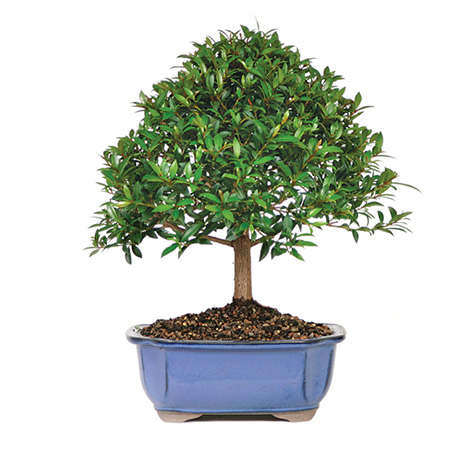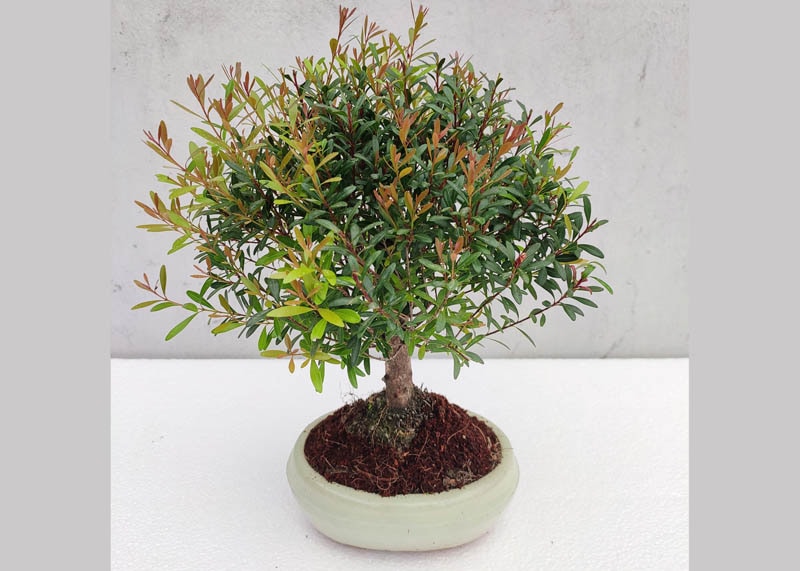Brush Cherry Bonsai trees require consistent watering and ample sunlight. They thrive best in well-drained soil and high humidity.
Brush Cherry Bonsai trees, known for their glossy leaves and beautiful flowers, make excellent indoor plants. To ensure healthy growth, place them in a well-lit area. They prefer a humid environment and should be watered regularly to keep the soil moist but not soggy.
Pruning is essential to maintain their shape and encourage new growth. These trees also benefit from occasional fertilization during the growing season. Regular monitoring for pests and diseases will help keep the plant healthy. With proper care, Brush Cherry Bonsai trees can thrive and add a touch of elegance to any indoor space.

Credit: www.bonsaioutlet.com
Introduction To Brush Cherry Bonsai
The Brush Cherry Bonsai thrives with proper care, offering vibrant foliage and charming blossoms. Pruning regularly and ensuring adequate sunlight are essential for its growth.
Origin And History
The Brush Cherry Bonsai comes from Australia. It is also found in New Zealand. This tree is popular for its beautiful flowers. It blooms with white or pink flowers. The Brush Cherry Bonsai has been grown for many years. People love its shiny leaves and bright red berries. Many bonsai lovers like to grow this tree. It is easy to shape and care for.
Unique Features
The Brush Cherry Bonsai has many unique features. Shiny leaves make it look very attractive. The leaves are dark green and small. This tree blooms with lovely flowers. The flowers can be white or pink. After the flowers, bright red berries appear. These berries add color to the tree. The Brush Cherry Bonsai is also known for its smooth bark. The bark is grey and looks very nice. This tree is perfect for bonsai because it grows slowly.
Ideal Growing Conditions
Brush Cherry Bonsai thrives in bright, indirect sunlight and well-drained soil. Maintain moderate humidity and water consistently to keep the soil moist.
Light Requirements
Brush Cherry Bonsai trees need bright, indirect light. Direct sunlight can harm the leaves. A spot near a window is perfect. Rotate the tree often. This ensures even light exposure. Without enough light, growth slows down. Leaves may drop if it’s too dark.
Temperature Preferences
Brush Cherry Bonsai trees like warm temperatures. Keep them in a room between 65°F and 75°F. Avoid placing the tree near cold drafts. Sudden temperature changes can stress the tree. In winter, keep it away from heaters. Extreme heat can also be harmful.
Watering Guidelines
Ensure the soil of the Brush Cherry Bonsai Tree remains consistently moist, never allowing it to dry out completely. Water thoroughly, letting excess water drain out to prevent root rot.
Frequency And Amount
Brush Cherry Bonsai trees need regular watering. Check the soil daily. Water the tree when the topsoil feels dry. Do not let the soil dry out completely. Use lukewarm water for better absorption. Water until you see water draining from the pot’s bottom.
Signs Of Overwatering
Overwatering can harm your bonsai. Look for yellowing leaves as a sign. Mushy roots are also a warning. Fungal growth on the soil surface indicates too much water. If you notice these signs, reduce the watering frequency.
Soil And Fertilization
Caring for a Brush Cherry Bonsai Tree involves well-draining soil and balanced fertilization. Nutrient-rich soil ensures healthy growth and vibrant foliage.
Best Soil Mix
The best soil mix for Brush Cherry Bonsai includes loam, peat moss, and sand. This mix allows good drainage and aeration. Roots need air and water to grow well. Avoid heavy soils that hold too much water.
Nutrient Needs
Brush Cherry Bonsai needs balanced fertilization. Use a slow-release fertilizer every few months. Liquid fertilizers can be used weekly during the growing season. Make sure to use fertilizers with nitrogen, phosphorus, and potassium. These elements help the tree grow strong and healthy.
Pruning And Shaping
Use sharp scissors or shears for clean cuts. Make sure tools are clean to avoid infection. Trim unwanted branches to shape the tree. Wire branches carefully to guide their growth. Never bend branches too hard as they might break. Check the wire regularly to prevent cutting into the bark.
Prune in spring to encourage new growth. Cut back new shoots to maintain shape. Avoid heavy pruning in summer. Light trimming is best during this season. Autumn is good for structural pruning. Remove dead or weak branches in winter. Prune carefully to avoid damage during this dormant period.

Credit: www.bonsaiempire.com
Pest And Disease Management
The Brush Cherry bonsai tree attracts aphids, spider mites, and scale insects. These pests feed on the tree’s sap, weakening it. Aphids cluster on new growth, while spider mites create webs on leaves. Scale insects stick to branches and stems, appearing as tiny bumps.
Maintain good air circulation around the tree to keep pests away. Regularly inspect the tree for signs of infestation. Use a mild insecticidal soap to treat affected areas. Prune infested branches and dispose of them properly. Keep the bonsai in a clean environment to reduce risk.
Repotting Essentials
Repot your Brush Cherry Bonsai every 2-3 years. Early spring is the best time. Check the roots. If they are crowded, it’s time. Healthy roots ensure a healthy tree.
- Remove the tree from its pot.
- Trim away old and dead roots.
- Add fresh soil to the new pot.
- Place the tree in the center.
- Fill the pot with soil, covering the roots.
- Water the tree thoroughly.
- Keep the tree in a shaded area for a week.
Seasonal Care Routines
Brush Cherry bonsai trees thrive in warm weather. Place the tree in a sunny spot with plenty of light. Water the tree regularly but don’t let it sit in water. Prune the tree to maintain its shape and encourage new growth. Fertilize the bonsai every two weeks with a balanced fertilizer. Keep an eye out for pests like aphids and spider mites.
In autumn, reduce watering as the tree enters dormancy. Move the tree indoors if temperatures drop below freezing. Place it in a cool, bright location. Water sparingly but do not let the soil dry out completely. Avoid fertilizing during the winter months. Check for any signs of disease or pests.
Advanced Care Tips
Prune the Brush Cherry Bonsai regularly to stimulate growth. Use clean and sharp tools to avoid damage. Apply organic fertilizers monthly for better root development. Ensure the soil remains moist but not waterlogged. Place the bonsai in bright, indirect light to support healthy growth.
Shape the bonsai using wire to guide branch growth. Trim excess leaves to enhance its appearance. Keep the leaves shiny by wiping them with a damp cloth. Rotate the bonsai occasionally to ensure even light exposure. Decorate the pot with small rocks or moss for added beauty.

Credit: www.bonsaiboy.com
Conclusion
Caring for a Brush Cherry Bonsai Tree is rewarding. Follow the tips for watering, pruning, and sunlight. Your tree will thrive and enhance your space. Enjoy the beauty and tranquility it brings. A well-maintained bonsai can be a stunning, lifelong companion.
Happy gardening!

